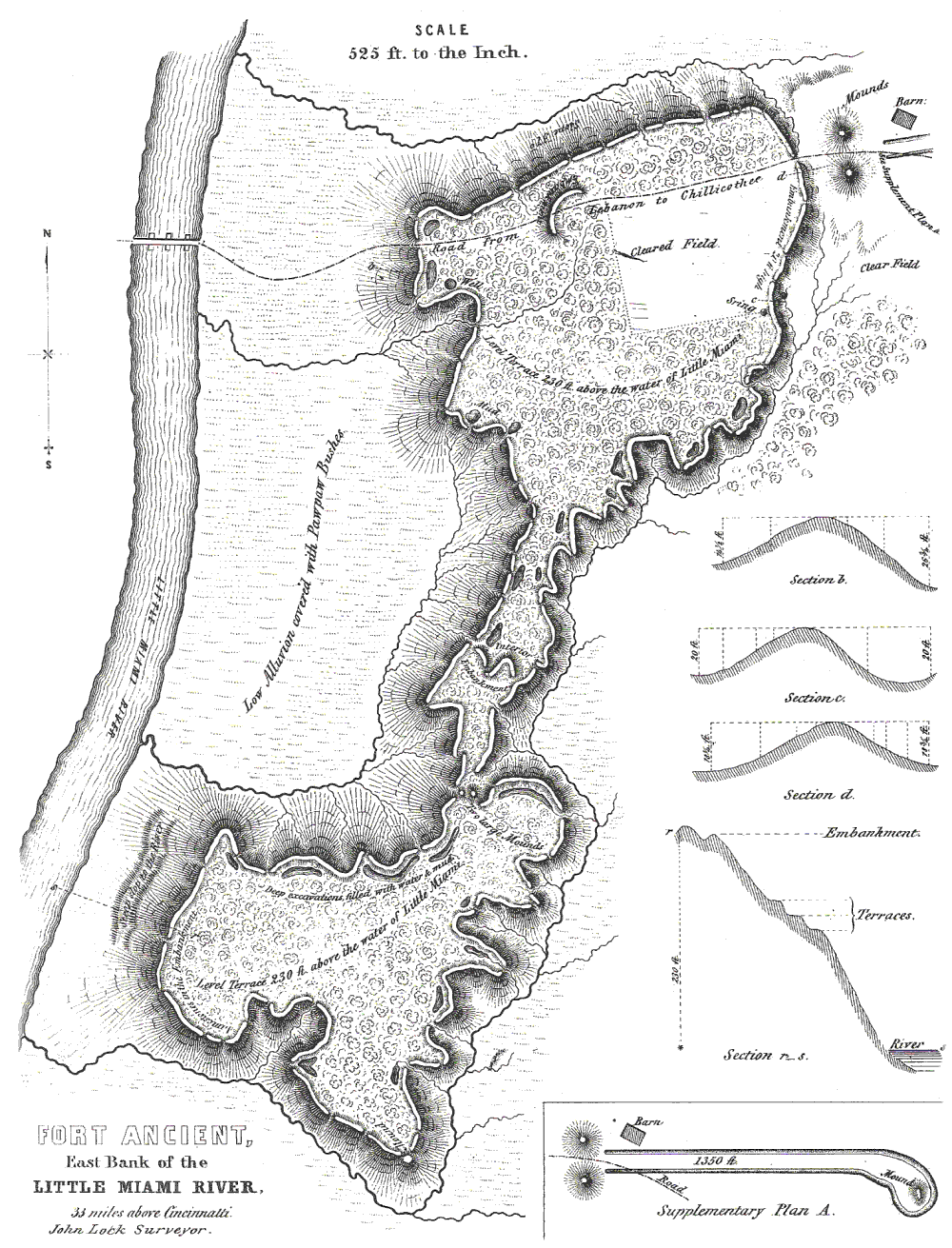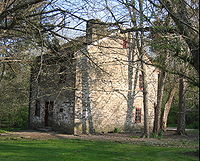
Fort Ancient, Ohio
Encyclopedia
Fort Ancient is a collection of Native American
earthworks
located in Washington Township
, Warren County, Ohio
, along the eastern shore of the Little Miami River
about seven miles (11 km) southeast of Lebanon
on State Route 350. The site is the largest prehistoric hilltop enclosure in the United States with three and one-half miles (18,000 ft) of walls in a 100 acre (0.404686 km²) complex. Built by the Hopewell peoples, who lived in the area from the 1st century BC to the 6th century AD, the site is situated on a wooded bluff 270 feet (82.3 m) above the Little Miami.
Maintained as a state historical park, the site was designated a National Historic Landmark
for its significance. In addition, this is part of the Hopewell Ceremonial Earthworks, one of 14 sites nominated in January 2008 by the Department of Interior for potential submission by the United States to the UNESCO World Heritage List.
 Scholars originally thought the site was created to provide shelter against enemies, but research has changed their opinion. The site presents anomalies inconsistent with defensive use:
Scholars originally thought the site was created to provide shelter against enemies, but research has changed their opinion. The site presents anomalies inconsistent with defensive use:
The prevailing scholarly opinion now is that the walls were designed for social and ceremonial purposes related to significant astronomical events. In the Northeast corner of the complex, four circular stone-covered mounds are arranged in a square. They apparently functioned as a calendar; gaps in the walls were aligned to highlight significant seasonal positions of the rising sun and moon.
In 2005 a circular arrangement of posts nearly 60 meters in diameter was discovered. At the center of the ring lies a shallow basin of burned red clay. Now known as the Moorehead Circle
, research into its purpose is ongoing.
The State of Ohio
purchased the land and made it Ohio's first state park in 1891. It has also been designated a National Historic Landmark
.
, and the impact of Europe
ans who migrated to the area and came into conflict with its inhabitants. The Museum also contains a classroom, a research area, and a gift shop. The site is open to the public from April through October; group tours are available by appointment on a year-round basis.
 In the 1800s to early 1900s a village existed on the eastern bank of the Little Miami River, at the base of the Fort Ancient Earthworks. The village once had a post office, hotel, blacksmith shop and other businesses and residence. The village no longer exists, but is currently the home of a canoe livery and a private campground.
In the 1800s to early 1900s a village existed on the eastern bank of the Little Miami River, at the base of the Fort Ancient Earthworks. The village once had a post office, hotel, blacksmith shop and other businesses and residence. The village no longer exists, but is currently the home of a canoe livery and a private campground.
In the 19th century, Fort Ancient was a stop on the Little Miami Railroad
. A historic tavern called the Cross Keys Tavern
remains on the east side of the river and is listed on the National Register of Historic Places
. The area is currently a public access to the Little Miami Bike Trail
, which occupies the former railway land that follows the River. There is a public access and parking for the Little Miami River at the site.
Native Americans in the United States
Native Americans in the United States are the indigenous peoples in North America within the boundaries of the present-day continental United States, parts of Alaska, and the island state of Hawaii. They are composed of numerous, distinct tribes, states, and ethnic groups, many of which survive as...
earthworks
Earthworks (archaeology)
In archaeology, earthwork is a general term to describe artificial changes in land level. Earthworks are often known colloquially as 'lumps and bumps'. Earthworks can themselves be archaeological features or they can show features beneath the surface...
located in Washington Township
Washington Township, Warren County, Ohio
Washington Township is one of the eleven townships of Warren County, Ohio, United States. Located in the east central part of the county, it is the only one of the eleven that does not contain a municipality...
, Warren County, Ohio
Warren County, Ohio
Warren County is a county located in the state of Ohio, United States. The population was 212,693 at the 2010 census. Its county seat is Lebanon. Warren County was erected May 1, 1803, from Hamilton County, and named for Dr...
, along the eastern shore of the Little Miami River
Little Miami River
The Little Miami River is a Class I tributary of the Ohio River that flows through five counties in southwestern Ohio in the United States. The Little Miami joins the Ohio River east of Cincinnati. It forms parts of the borders between Hamilton and Clermont counties and between Hamilton and Warren...
about seven miles (11 km) southeast of Lebanon
Lebanon, Ohio
The population at the 2010 census was 20,033. As of the census of 2000, there were 16,962 people residing in the city. The population density was 1,440.6 people per square mile . There were 6,218 housing units at an average density of 528.1 per square mile...
on State Route 350. The site is the largest prehistoric hilltop enclosure in the United States with three and one-half miles (18,000 ft) of walls in a 100 acre (0.404686 km²) complex. Built by the Hopewell peoples, who lived in the area from the 1st century BC to the 6th century AD, the site is situated on a wooded bluff 270 feet (82.3 m) above the Little Miami.
Maintained as a state historical park, the site was designated a National Historic Landmark
National Historic Landmark
A National Historic Landmark is a building, site, structure, object, or district, that is officially recognized by the United States government for its historical significance...
for its significance. In addition, this is part of the Hopewell Ceremonial Earthworks, one of 14 sites nominated in January 2008 by the Department of Interior for potential submission by the United States to the UNESCO World Heritage List.
Construction
The Fort Ancient earthworks were built in three stages over an estimated 400 year period. The shoulder blades of deer, split elk antlers, clam shell hoes, and digging sticks were used to loosen the dirt, and baskets holding 35 to 40 pounds were used to carry and distribute it. Archaeologists estimate the total volume of earth in the walls at 553000 cubic yards (422,798.8 m³).Purpose

- Ditches are located inside the walls, rather than outside as a means of defense.
- More than 60 gateways, which could not have been quickly blocked in case of attack, are present in the walls.
- Evidence has not been found for the number of occupants necessary for a significant defense force.
The prevailing scholarly opinion now is that the walls were designed for social and ceremonial purposes related to significant astronomical events. In the Northeast corner of the complex, four circular stone-covered mounds are arranged in a square. They apparently functioned as a calendar; gaps in the walls were aligned to highlight significant seasonal positions of the rising sun and moon.
In 2005 a circular arrangement of posts nearly 60 meters in diameter was discovered. At the center of the ring lies a shallow basin of burned red clay. Now known as the Moorehead Circle
Moorehead Circle
Moorehead Circle was a triple woodhenge constructed about two millennia ago at the Fort Ancient Earthworks in the U.S. state of Ohio.The outer circle, discovered in 2005 by Jarrod Burks, is about 60 meters in diameter...
, research into its purpose is ongoing.
The State of Ohio
Ohio
Ohio is a Midwestern state in the United States. The 34th largest state by area in the U.S.,it is the 7th‑most populous with over 11.5 million residents, containing several major American cities and seven metropolitan areas with populations of 500,000 or more.The state's capital is Columbus...
purchased the land and made it Ohio's first state park in 1891. It has also been designated a National Historic Landmark
National Historic Landmark
A National Historic Landmark is a building, site, structure, object, or district, that is officially recognized by the United States government for its historical significance...
.
Museum
The site now includes a 9000 square feet (836.1 m²) museum covering 1500 years of American Indian heritage in the Ohio Valley. Topics include the earliest people to settle in North America, the development of agricultureAgriculture
Agriculture is the cultivation of animals, plants, fungi and other life forms for food, fiber, and other products used to sustain life. Agriculture was the key implement in the rise of sedentary human civilization, whereby farming of domesticated species created food surpluses that nurtured the...
, and the impact of Europe
Europe
Europe is, by convention, one of the world's seven continents. Comprising the westernmost peninsula of Eurasia, Europe is generally 'divided' from Asia to its east by the watershed divides of the Ural and Caucasus Mountains, the Ural River, the Caspian and Black Seas, and the waterways connecting...
ans who migrated to the area and came into conflict with its inhabitants. The Museum also contains a classroom, a research area, and a gift shop. The site is open to the public from April through October; group tours are available by appointment on a year-round basis.
Fort Ancient Village

In the 19th century, Fort Ancient was a stop on the Little Miami Railroad
Little Miami Railroad
The Little Miami Railroad, now defunct, was a railway of southwestern Ohio, running from the eastern side of Cincinnati to Springfield, Ohio. By merging with the Columbus and Xenia Railroad it created the first through rail route from the important manufacturing city of Cincinnati to the state...
. A historic tavern called the Cross Keys Tavern
Cross Keys Tavern
The Crossed Keys Tavern, also known as the Cross Keys Tavern is an historic stone building located in Turtlecreek Township near Lebanon, Ohio. It is across the Little Miami River from the former Fort Ancient village. Built in 1802, it was operated as a tavern from 1809-1820..On October 21, 1976,...
remains on the east side of the river and is listed on the National Register of Historic Places
National Register of Historic Places
The National Register of Historic Places is the United States government's official list of districts, sites, buildings, structures, and objects deemed worthy of preservation...
. The area is currently a public access to the Little Miami Bike Trail
Little Miami Bike Trail
The Little Miami Scenic Trail, also known as the Little Miami Scenic River Trail and Little Miami Bike Trail, is a rail trail that runs though five southwestern counties in the U.S. state of Ohio. The multi-use trail sees frequent use by hikers and bicyclists, as well as the occasional horseback...
, which occupies the former railway land that follows the River. There is a public access and parking for the Little Miami River at the site.
See also
- Moorehead CircleMoorehead CircleMoorehead Circle was a triple woodhenge constructed about two millennia ago at the Fort Ancient Earthworks in the U.S. state of Ohio.The outer circle, discovered in 2005 by Jarrod Burks, is about 60 meters in diameter...
- List of Registered Historic Places in Warren County, Ohio
- Fort AncientFort AncientFort Ancient is a name for a Native American culture that flourished from 1000-1750 CE among a people who predominantly inhabited land along the Ohio River in areas of modern-day Southern Ohio, Northern Kentucky, Southeastern Indiana and Western West Virginia. They were a maize based agricultural...
- List of Hopewell sites

